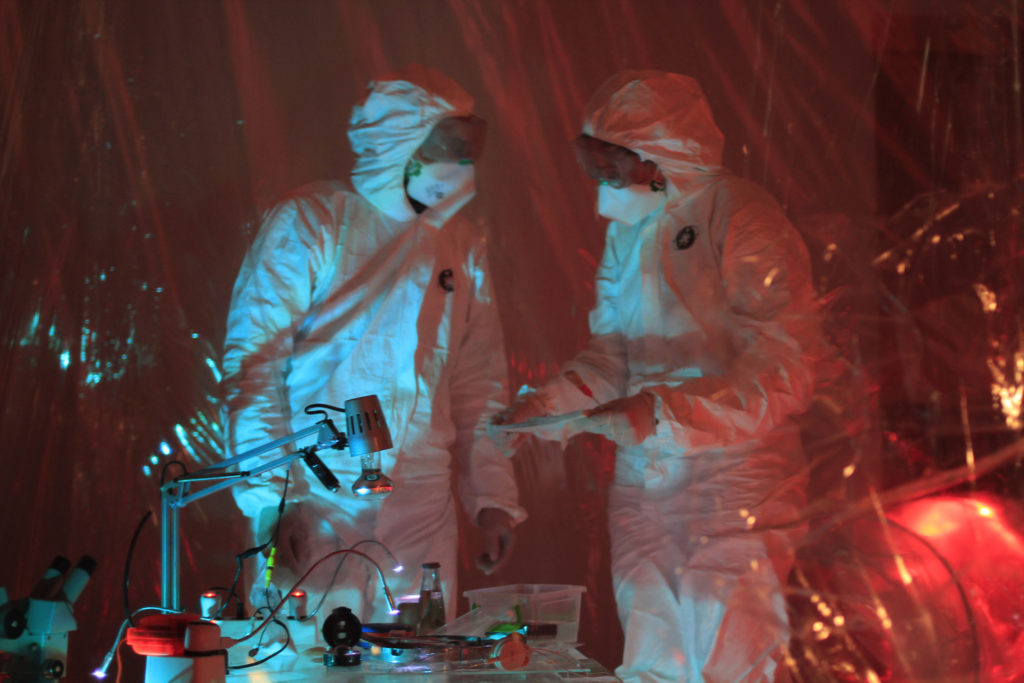The avant-garde unconscious at kinema ikon: From experimental film to hypermedia
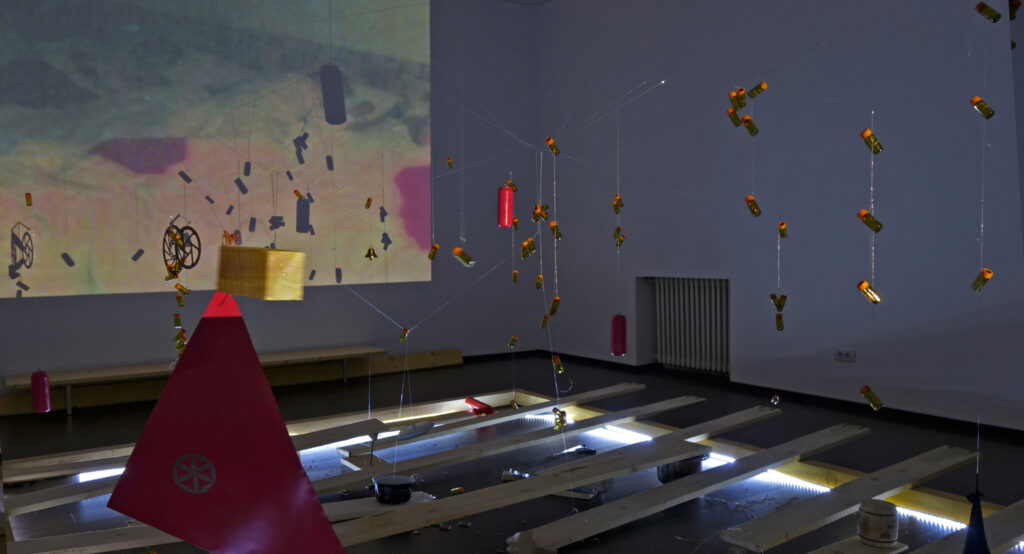
*A version of this essay was initially published under the title „The avant-garde unconscious: On kinema ikon’s (filmic) practice” in „kinema ikon: films 1970-2020”, catalogue edited by Călin Man1
Kinema ikon is one of the very rare examples of artists’ collectives whose activity is noteworthy equally for its longevity – the group is continuously active during the last fifty years (!), and an excellent artistic performance – a relentless appetite for research and experiment, doubled by engaging, intelligent visual solutions, imaginative humor and sound conceptual thinking. A lot has changed politically, socially and artistically over this period of time. Kinema ikon has changed a lot, too. Their long and prodigious career includes experimental film during communist times between 1970 and 1990, hypermedia in response to the Internet and CD-ROM boom of the nineties, and, since the mid-2000s, multimedia and extended collaborations. However, while browsing through this comprehensive and amazing body of work, one would notice a constant feature, notwithstanding the numerous changes the group went through in what concerns people involved, artistic approaches and social environment. This feature is represented by the omnipresent innovation and exploration of new territories, critical imagination, the constant quest to expand the medium and its condition as well as the pursuit to find solutions for interpreting and sabotaging reality. I call this attitude “the avant-garde unconscious.”
While the expression is not an innocent one, I want to strip it bare from any additional theoretical burden, and propose to conceptualize it simply – with all the risks assumed – as the internalization of the spirit of the avant-garde by kinema ikon in their artistic practice (film or other media forms). Internalization meaning the (un)conscious absorption of certain cultural patterns and artistic values and, at the same time, the act of undermining and complicating them. That is, a combination between inductive reasoning based on experience and concept, and the instinctive need to take a step ahead while prospecting the openings, the non-obvious, the newness (or, as Rosalind Krauss put it in her meaningfully titled text, the „possibility for vision itself”). 2 In other words, it means to acknowledge avant-garde as an implicit condition, while operating an autonomization of the artistic act vis-à-vis the rationalization and historicization of the avant-garde. Certainly, kinema ikon’s practice maps onto the avant-garde logic (one that is actually not historically circumscribed) in what concerns aesthetic radicalism and anti-establishment command, although the group has never adopted similar logistic or communicational strategies – such as publishing premeditated “manifestos” or engaging in a programmatic scheme – preferring instead an intuitive artistic attitude and organic collaborative work. This is evident in the assumed underground and/or marginal status, one that – perhaps paradoxically – didn’t prevent them from being synchronous with what was happening under the lights of the artistic international mainstage during these decades.
The historical avant-garde in Romania was quite radical, much of its scope and force being given by numerous publications and the influential personalities involved, most of them maintaining important links with their international peers. However, the Romanian avant-garde had no great appetence for filmmaking: written invective and rebel painting were preferred to any lens-based discourse. Given this absent legacy to which we should add the lack of any direct connection between the historical avant-garde, neo-avant-garde and what followed afterwards (due to the cultural hiatus imposed by communism), one would legitimately ask where kinema ikon took their drive and vision? Theorist George Săbău, the veteran leader of kinema ikon, provides an answer to this question when he mentions that the group was always in search for “something else – differently.”3 Indeed, the group’s working ethics focused on innovation and “difference” is what characterizes (the avant-garde unconscious of) kinema ikon in the first place.
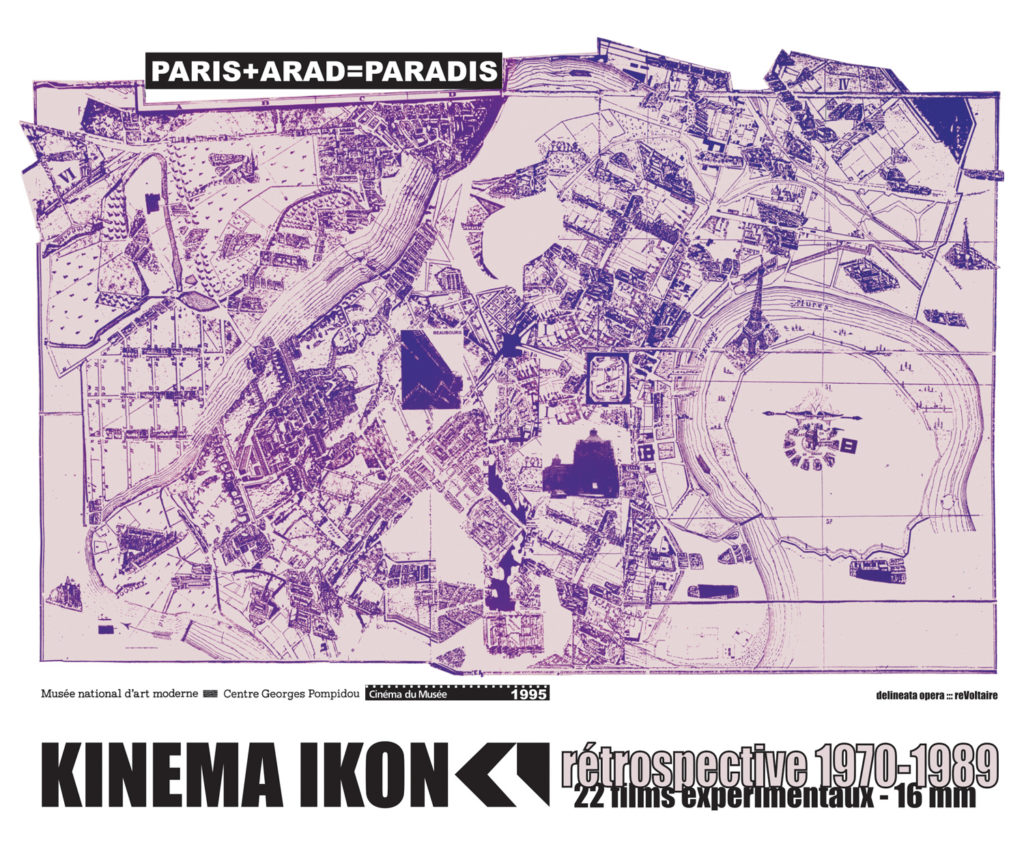
Interdisciplinary
The avant-garde unconscious has numerous manifestations and works in various ways at different levels. One aspect that accounts for this status at kinema ikon is the assumed diversity. Firstly, the people involved. From the very beginning, those working within and around kinema ikon came from an assortment of professions and artistic backgrounds, and this played a key role in the group’s hybrid and ingenious production. Moreover, kinema ikon – as a cine-club or as an artistic group – has always been involved in organizing/participating in intense exchanges and interdisciplinary meetings in smaller or larger, but always diverse circles, both before and after the fall of the Iron Curtain. Their organizational identity in the seventies and eighties was not unlike similar enterprises such as The London Film-makers’ Co-op (LFMC), The Film-Makers’ Cooperative founded in 1962 in New York City by Jonas Mekas, Shirley Clarke, Stan Brakhage, and others, or, in Eastern Europe, the Workshop of Film Form in Łódź, The Balázs Béla Studio in Budapest, Independent Videoart Prague, and the Cinema Clubs from several cities in former Yugoslavia. Equally important for the interdisciplinary ethos of the group is the Media Arts Festival organized in Arad by Călin Man and Ileana Selejan since 2014, a spin-off of kinema ikon project. All these organizational commitments helped shape kinema ikon’s values, attitudes and forms. But, perhaps the most evident expression of the diversity affirmed by the group is the artistic production itself that spans five decades and cover many genres and mediums, analog and digital, online and offline, pluri-centric and ex-centric (to which I will shortly turn).
Political
The eclecticism embraced by kinema ikon has effect also on political grounds – another important aspect of the avant-garde unconscious. Falling between genres, mediums and categories, that is, rejecting a clear working typology and artistic profiling was in itself a critical gesture with political undertones during communist times. If this was not well regarded by politically-controlled institutions (also because censorship never really understood the experimental films), it nonetheless helped the group maintain a self-imposed marginal/underground status, a convenient situation since it left them room for meetings, creativity and intellectual exchanges. Moreover, the group’s consistent documentary film production on officially accepted themes (history, ethnography, personalities) helped the group to maintain not only the needed legitimization, but also to obtain the equipment necessary for producing experimental films (interestingly, there are 62 documentary films, paralleled by exactly the same number of experimental films, made between 1970 and 1990).
But there is yet another aspect of the political incidence of kinema ikon’s avant-garde unconscious, especially before the Iron Curtain, and this is related to the East-West equation. The group’s progressive vision and diversity, together with their sustained up-to-date-ness and consonance with the “grand” artistic narratives from the West, challenge the simplistic reading of the East-West cultural divide. More exactly, kinema ikon is very efficient in relativizing the opinion that sees the equation West-East as a rapport between center and periphery, between the dominant model and the “weak” term. While taking Western culture as the model to follow – like almost all Eastern European artists – kinema ikon developed somehow unconsciously a certain cultural “perspective that would emphasize the ‘otherness’ of their part of the continent,” as art historian Piotr Piotrowski has observed.4 This “otherness” is (or rather was) represented, on the one hand, by the “conviction in the power of art, something that has vanished long before in the West,”5 and, on the other, by a certain state of exception or idiosyncrasy, a way to construct a different, most of the times subversive set of norms and codes, and, importantly for kinema ikon at least, a genuine appetence for humor. Although the latter’s subversive power has certainly changed after 1990, it still plays a political function for kinema ikon today. George Săbău’s statement is clear in this sense: “Between militant activism and experimental playfulness, the KI group opted, and still does, for the latter.”6 Kudos, ki!
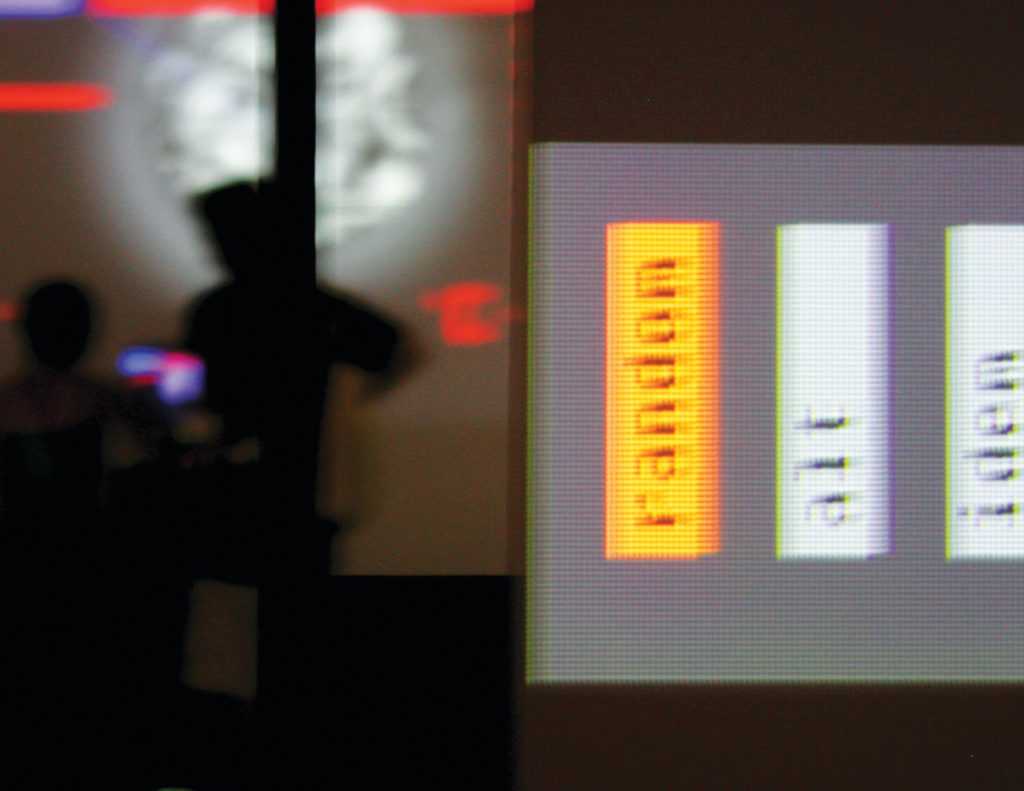
Humor
Indeed, humor and irony are other key manifestations of the avant-garde unconscious. They were efficient weapons for avant-garde artists of all generations, simply because they were destabilizing in and of themselves. Through various strategies that involve sarcasm, wit and wordplay, this attitude has the capacity to disrupt the public sphere, to engage in polemics and to shock the bourgeoisie and mainstream art. Moreover, it is important to note that humor and irony were effective survival strategies during the communist oppressive regime. However, if this avant-gardist arsenal was present at kinema ikon, it was not used by the group to act out an open dissidence and direct power critique. Rather, kinema ikon, opted in a discreet manner for the double entendre, intelligent irony and absurd content, all of them constant features in their artistic production over the years. Operating on these coordinates, as George Săbău has emphasized, the members of the group played “an essential part in the act of instating an inciting, provocative, ludic, ironic, intellectual climate, also freed from cultural clichés, language stereotypes, ‘idola theatri’; they have permanently promoted an unconventional attitude, which induced the experiment atmosphere a continuous ‘facultas ludentes’.”7 Many titles of their works are relevant in this sense (to name just a few, equally from the group’s filmic production and hypermedia/multimedia years): Kitsch, Kitsch, Ura! (Daniel Motz, 1977), Bopacul (kinema ikon, 1979), Nu trageți în pianist / Don’t shoot the piano player (Romulus Bucur, 1984), Mise-en-écran (Roxana Cherecheș & Liliana Trandabur, 1989), Ready Media (kinema ikon, 1995), Opera Prima (kinema ikon, 1996), Commedia del Multimedia (kinema ikon, 1997), alteridem.exe (kinema ikon, 2002; 2003), Uninvited.Rușine (reVoltaire, 2003-2016), Skepsis (kinema ikon, 2011) 46016’92”N 21031’57”E / ȘANTIER ARGHEOLOGIC / 4175 A.D. (geosab & kf, 2015), ki:ss (kinema ikon, 2015), DADADA (reVoltaire, 2016), kºi—∆r.mΩ1øø (kinema ikon, 2017), OST’n’ReST (kinema ikon, 2019), etc.8
Aesthetics
Another way in which the avant-garde unconscious resurfaces in kinema ikon’s artistic practice, one that is symptomatic for their vision and mission, is related to aesthetics. More exactly, this is about the unique combination between, on the one hand, a DIY philosophy, wit and improvisation and, on the other, a rigorous research, intense readings and careful construction of the visual vocabulary. This crisscrossed approach led to a working strategy focused on the permanent investigation of various – read new – visual expressions, thought-provoking messages and conceptualizations, and on a methodology aimed at ever pushing the limits of the medium. Kinema ikon was interested, basically, in all the categories of the experimental film genre and, later, in exploring most of the possibilities offered by installationism, digitality, network production and hypermedia. Some of the works authored individually or as a group should be mentioned here as they illustrate these diverse interests and, in this sense, are instrumental in explaining the avant-garde unconscious of the group’s working philosophy.
In the field of experimental film production, we should note George Săbău’s Ipostaze simultane / Hypostases (1970), where one can identify the typical experimental film vocabulary that will later become the mark of most of the group’s films: split screen, superimpositions, jump cuts, put at work to deliver a vague and bizarre narration. In the same vein, Emanuel Ţeţ’s Dynamic Poem (1978) and Ioan Plesh’s Panta Rhei (1979) employ a series of techniques – hand painting and scratching on the film strip – that turn the film into a gestural, intimate discourse, with a strong visual impact, projects which could easily compete with similar endeavors such as Lettrist experimental films of the fifties in France, and U.S. neo-avant-garde filmmaking of the sixties and seventies. Roxana Cherecheş & Liliana Trandabur’s Mise en écran (1989) evokes Surrealist sensibilities, in a pseudo-narrative that reminds of Maya Deren’s dreamlike images. And if we are to find other similarities, we should also note George Săbău’s Fragmentarium (1985-1990) a film that, like Stan Brakhage’s visual experiments, proposes a refined image that reveals a keen interest in textures and natural forms, employed not for their power of signification but rather for their optical function. Călin Man’s What’s happening (1986-1994) is constructed according to a non-linear logic, with an incongruous relationship between image and sound, a solution that anticipates, somehow, the later hyper-textual constructions of the group’s digital period. The same strategy is employed in Călin Man’s K_attacK (2005), although within a fully animated film that speculates the gadgetry and the effect, while borrowing elements from his previous work Esoth Eric, which was part of the larger project alteridem.exe_2 presented at the Venice Biennale in 2003. 9
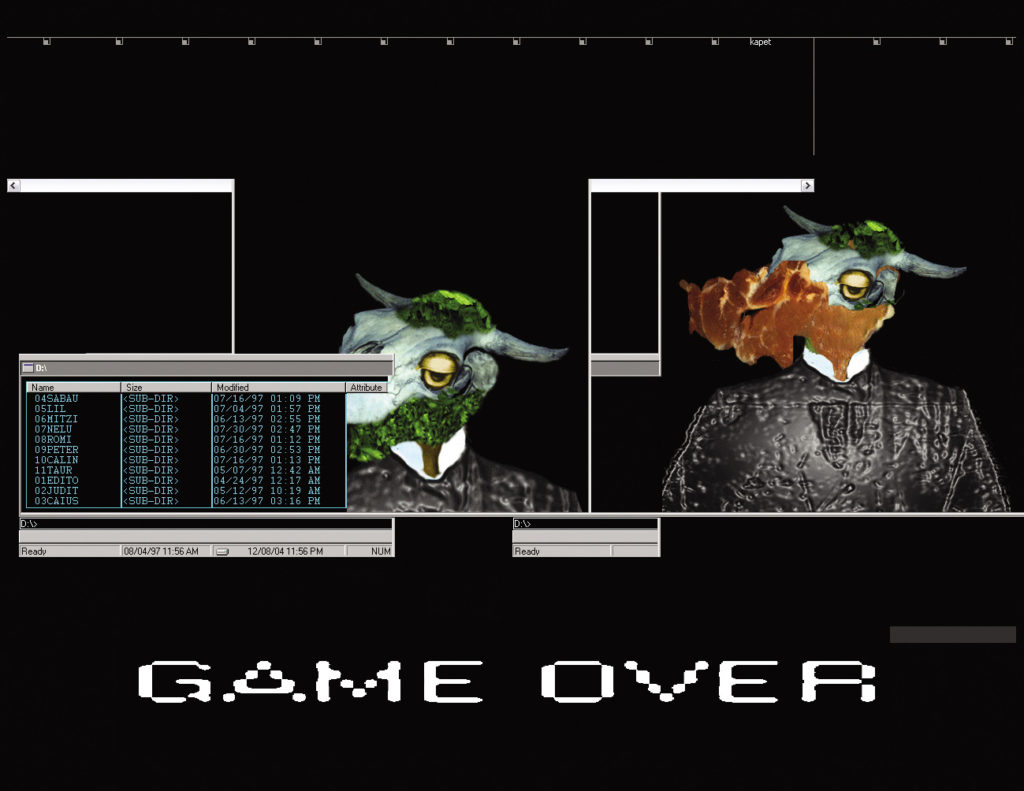
Among the numerous examples of the group’s works which are related to various forms of hypermedia we should mention Ready Media (1995) a somehow programmatic project that makes an unequivocal reference to the conceptual and material forms of historical avant-garde and which emphasizes, once more, the group’s avant-garde unconscious. Opera Prima, (1996) assumes – via its title – a “primordial” position, an ironic, although serious way to claim avant-garde’s close-and-restart strategies. Commedia del Multimedia, (1997), a work with a captivating title, a pun which makes (postmodern) references to established cultural benchmarks and to the contemporary, inescapably hybrid, media sphere. alteridem.exe, (2002, 2003) makes a direct reference to the file extension of an executable program in Windows environment, an excellent illustration of Lev Manovich’s catchphrase/book title, “Software takes command”. Wunderkammer, (2011, 2012, 2015 ongoing) is a concept-collection, and then a permanent exhibition, a combination between the cabinet of curiosities and a technical museum which functions as a statement referring to the forward-thinking (technologies) as a guiding light for the group (or what I call here avant-garde unconscious). Serial (2013-2016) was a series of interventions by invited artists and curators who worked in collaboration with / employing works by kinema ikon, a symptomatic example of crowdsourcing and auctorial decentralization. OST’n’ReST (2019) is a collaboration between five Romanian and five Belgian artists who were asked to rescore a selection of ten experimental films produced by kinema ikon for a World Première at the Ghent Film Festival / Vooruit Ghent, followed by a tour.
Fragmentation
The fact that most of the works produced by kinema ikon, old and new, are based on abstraction, repetition and visual discontinuity, points to another aspect of the avant-garde unconscious: the propensity for the fragment, i.e., the recourse to fragmentation as an artistic strategy. Fragmentation is one of the avant-garde’s dearest tactics – see its use in collage, photomontage, film montage, assemblage etc. – precisely for its efficiency in radically undermining the idea of the image as a homogeneous representation, fluid narrative and unitary surface. For example, the introduction of collage by the cubists and the dadaists was meant to break with the tradition of pictorial mimesis, leading, on the one hand, to the hybridization of painting and, on the other, to the creation of a concrete relationship with reality. In cinema, Dziga Vertov (among others) promoted the idea of the fragmentary image and montage as revolutionary tools “on the belief that the moving image can reorganize society and sight, reform vision, and liberate maker and viewer alike.”10 The neo-avant-garde and the artistic movements that followed made full use of the fragment and its aesthetic potential, especially in installationist circumstances and performative situations, fueled as they were by the deconstructivist karma floating around. In installation, the metonymic cultivation of the fragment – of the object that contains and determines the whole – and the interplay between contiguous components are defining features for the genre. In the performative act, fragmentation works through decorporealization and by assigning a functional autonomy to the anatomical fragment by delegating functions and senses. New media and remix culture contributed in a radical manner to expand and complicate the visual and conceptual potential of the fragment proposing different forms of multi-perspectival narration, unstable visualization, temporal aggregation, collective production and plurality of reception. The result is a radical questioning of basic values in art, such as uniqueness, authorship, originality and copyright.
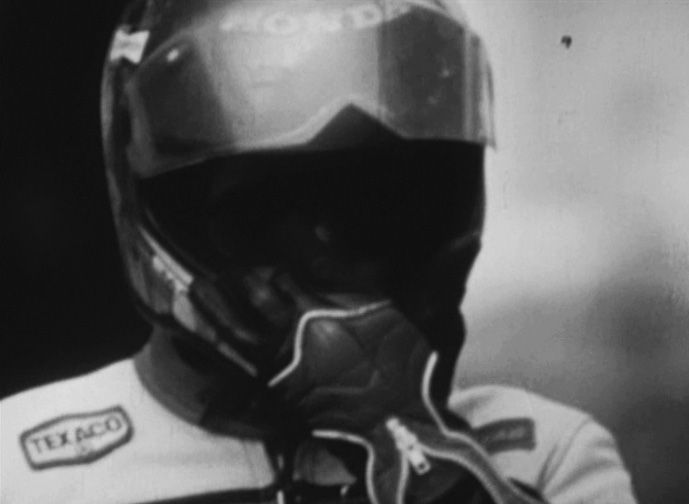
Kinema ikon has absorbed and employed all these potentialities of the fragment equally as a background (or rather unconscious) expression of avant-gardism and as a solution to deal with the symptoms of the contemporary art condition. Fragmentation, therefore, was seen not so much the goal, as a means to address the message, the medium and the masses. A few examples are relevant in this sense: Alexandru Pecican, Exercițiu subliminal / Subliminal Exercise (1979), a film that alternates between intimate and public scenes shot at various speeds with hallucinatory effects that match the psychedelic soundtrack; George Săbău’s Decupaje / Cuting ups (1980-1985), a film with a programmatic title, which presents a sequence of random images taken with different framings, in different locations, their aleatory articulation effectively turning them into simple visual signs; Ioan Plesh’s, Emergenţă / Emergence (1982), a poetic succession of images that acquire new meanings in the ensemble (plus the author’s trademark motions: drawings on film, solarizations and superimpositions); kinema ikon’s, Ready-Media (1995) a group video installation based on a series of images recorded from TV broadcast which create an ample video collage, an absurd exercise of manipulation that actually points to the fragility of “truth” in mass media; mistik&01’s, Digital Body (2006) an almost abstract, but poetic rendition of a body painted with digits; kinema ikon’s, Skepsis (2011) a fast-forward, disruptive view of a virtual “wunderkammer.”
Most of the works mentioned above demonstrate that through the manipulation of the fragment, audacious montage, and an unorthodox approach to apparatus, the final product becomes an entity with its own visual and conceptual condition, rather than a simple mimetic trace of reality or an expression of a “meaningful”, linear narration. Speaking about the aesthetic relevance of the fragment at kinema ikon, art theorist Cristian Nae rightly observes that the group’s works show “an insistence on the autonomous fragment of reality, which is decontextualized until it reaches the state of a seemingly meaningless grapheme.” 11 Rightly so, since, we should remember that, at least in a certain historical moment (that is, during communism), this was a strategy to emancipate the artistic discourse from a profoundly politicized reality. Building and assuming aesthetic autonomy was – unlike in the West, where it was identified with medium purity, abstraction and alienation – an approach aimed at tacitly confronting official artistic norms and creating a distinct artistic discourse. Nonetheless, the open-endedness and hybridization unfolding through fragmentation acquired a different, extended dimension during kinema ikon’s later digital phase, thus confirming its aesthetic meaningfulness, regardless of epoch or context.
Conclusion
So, it might become clear now that the phrase avant-garde unconscious is a theoretical tool that has relevance and applicability to various periods within the history of kinema ikon and, thus, might cut across any attempt to fix the group’s activity within the divisive modern/post-modern framework. On the one hand, the avant-garde unconscious in kinema ikon’s practice can be read in a modernist key as it activates aesthetic autonomy, self-reflexivity, the structural exploration of the medium through image and montage, artistic means that work within the logic of avant-garde precepts and neo-avant-garde explorations. However, any such identification is problematic: the avant-garde unconscious is to (neo)avant-garde what, in Jacques Lacan’s opinion, the unconscious is to reason: not something different, but something outside of it. On the other hand, the avant-garde unconscious seems to be a post-modernist affair, as well. The inclination towards hybridity, recycling images, post-mediality and ironic references would signal a post-modern sensibility. Nonetheless, while kinema ikon’s practice defies rigid modernist values, it also demonstrates that the group’s work is and has always been genuinely new and, horribile dictu, original! A very effective way to suggest that – paraphrasing Bruno Latour – we have never been postmodern. Actually, George Săbău is clear in defying these cultural patterns and differences: “nothing can stop us [from] including digital experimental films in the same paradigm with the analogic ones, and both in the avant-garde movements.”12 Or, I would say, within the same conceptual and functional paradigm of the avant-garde unconscious.
Horea Avram, PhD, is an art historian, media theorist and independent curator. He researches and writes about media art, experimental film, representation theory, and visual culture. He teaches at the Department of Cinema and Media, Babeș-Bolyai University, Cluj-Napoca, Romania.
A version of this essay was initially published under the title „The avant-garde unconscious: On kinema ikon’s (filmic) practice” in kinema ikon: films 1970-2020, catalogue edited by Călin Man. Bucharest: kinema ikon/Dark Publishing, 2019, pp. 246-251.
Rosalind E. Krauss, The Optical Unconscious. Cambridge, Mass. and London, England: The MIT Press, 1993, p. 217.
George Săbău, „A contextual history of the kinema ikon group”, kinema ikon catalogue, edited by kinema ikon. Bucharest: The National Museum of Contemporary Art, 2005, p. 8. The leader of the group is presently Călin Man/reVoltaire.
Piotr Piotrowski, In the Shadow of Yalta. Art and the Avant-garde in Eastern Europe, 1945-1989. Translated by Anna Brzyski. London: Reaktion Books, 2009, p. 12.
Hans Belting, Art History after Modernism. Translated by Caroline Saltzwedel and Mitch Cohen, with Keneth Northcott. Chicago and London: The University of Chicago Press, 2003, p. 58.
George Săbău, „kinema ikon. Experimental films: analogic and digital”. In kinema ikon. Experimental films: analogic and digital 1970-2010, edited by kinema ikon, Arad: Art Museum Arad, 2010, unpaginated.
George Săbău, „A contextual history of the kinema ikon group”, Ibid. p. 16.
For more details, see kinema ikon
About the beginning of working with computer within kinema ikon, see Călin Man, “Interviu hackuit cu Călin Man, unul dintre principalii actori ai artei new media” by Ioana Calen. Vice, 4 November 2014.(accessed December 2019).
Erika Suderburg, “Database, Anarchéologie, the Commons, Kino-Eye, and Mash. How Bard, Kaufman, Svilova, and Vertov Continue the Revolution” in Resolutions 3. Global Networks of Video, edited by Ming-Yuen S. Ma and Erika Suderburg. Minneapolis and London: University of Minnesota Press, 2012, p. 99.
Cristian Nae, “Reality unbound. The politics of fragmentation in the experimental productions of kinema ikon,” Studies in Eastern European Cinema, 7: 1 (2016): 25-38.
George Săbău, „kinema ikon. Experimental films: analogic and digital”, Ibid.
